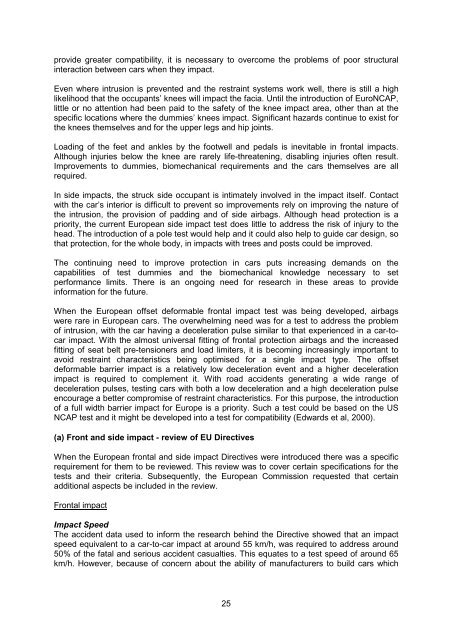PRIORITIES FOR EU MOTOR VEHICLE SAFETY DESIGN
priorities for eu motor vehicle safety design - ETSC
priorities for eu motor vehicle safety design - ETSC
Create successful ePaper yourself
Turn your PDF publications into a flip-book with our unique Google optimized e-Paper software.
provide greater compatibility, it is necessary to overcome the problems of poor structural<br />
interaction between cars when they impact.<br />
Even where intrusion is prevented and the restraint systems work well, there is still a high<br />
likelihood that the occupants’ knees will impact the facia. Until the introduction of EuroNCAP,<br />
little or no attention had been paid to the safety of the knee impact area, other than at the<br />
specific locations where the dummies’ knees impact. Significant hazards continue to exist for<br />
the knees themselves and for the upper legs and hip joints.<br />
Loading of the feet and ankles by the footwell and pedals is inevitable in frontal impacts.<br />
Although injuries below the knee are rarely life-threatening, disabling injuries often result.<br />
Improvements to dummies, biomechanical requirements and the cars themselves are all<br />
required.<br />
In side impacts, the struck side occupant is intimately involved in the impact itself. Contact<br />
with the car’s interior is difficult to prevent so improvements rely on improving the nature of<br />
the intrusion, the provision of padding and of side airbags. Although head protection is a<br />
priority, the current European side impact test does little to address the risk of injury to the<br />
head. The introduction of a pole test would help and it could also help to guide car design, so<br />
that protection, for the whole body, in impacts with trees and posts could be improved.<br />
The continuing need to improve protection in cars puts increasing demands on the<br />
capabilities of test dummies and the biomechanical knowledge necessary to set<br />
performance limits. There is an ongoing need for research in these areas to provide<br />
information for the future.<br />
When the European offset deformable frontal impact test was being developed, airbags<br />
were rare in European cars. The overwhelming need was for a test to address the problem<br />
of intrusion, with the car having a deceleration pulse similar to that experienced in a car-tocar<br />
impact. With the almost universal fitting of frontal protection airbags and the increased<br />
fitting of seat belt pre-tensioners and load limiters, it is becoming increasingly important to<br />
avoid restraint characteristics being optimised for a single impact type. The offset<br />
deformable barrier impact is a relatively low deceleration event and a higher deceleration<br />
impact is required to complement it. With road accidents generating a wide range of<br />
deceleration pulses, testing cars with both a low deceleration and a high deceleration pulse<br />
encourage a better compromise of restraint characteristics. For this purpose, the introduction<br />
of a full width barrier impact for Europe is a priority. Such a test could be based on the US<br />
NCAP test and it might be developed into a test for compatibility (Edwards et al, 2000).<br />
(a) Front and side impact - review of <strong>EU</strong> Directives<br />
When the European frontal and side impact Directives were introduced there was a specific<br />
requirement for them to be reviewed. This review was to cover certain specifications for the<br />
tests and their criteria. Subsequently, the European Commission requested that certain<br />
additional aspects be included in the review.<br />
Frontal impact<br />
Impact Speed<br />
The accident data used to inform the research behind the Directive showed that an impact<br />
speed equivalent to a car-to-car impact at around 55 km/h, was required to address around<br />
50% of the fatal and serious accident casualties. This equates to a test speed of around 65<br />
km/h. However, because of concern about the ability of manufacturers to build cars which<br />
25



